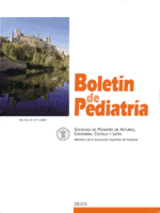Consumo de tabaco en adolescentes de un área rural de Asturias
M. Fernández Francés , A.J. Salas Riesgo
Bol. Pediatr. 2001; 41 (177): 168 - 174
Introducción. El consumo de tabaco en jóvenes y adolescentes constituye un importante problema de salud pública. El hábito suele adoptarse durante la adolescencia temprana. Se han descrito diversos factores que influyen en su inicio. Objetivo. Describir la prevalencia del consumo, los factores de riesgo y la actitud ante el tabaco en los adolescentes de un área rural de Asturias. Sujetos y métodos. Estudio descriptivo transversal. Sobre una muestra de 208 estudiantes de Enseñanza Secundaria del Área Sanitaria Suroccidental de Asturias, se realizó una encuesta estructurada y anónima. Las variables que se midieron fueron: edad, sexo, haber probado el tabaco, edad de inicio del consumo, frecuencia del mismo, nivel cultural de los padres, tabaquismo en personas cercanas, y actitud ante el tabaco. Resultados. La edad media de los encuestados fue de 15,2 ± 0,9 años (54,7% mujeres). El 41,8% había probado el tabaco, el 21,4% era fumador y el 13,9% fumaba a diario. La edad media de inicio del consumo fue 13 ± 2,1 años. El 60,7% de los padres y el 52,7% de las madres sólo tenían estudios primarios. El 43,9% reconoció que fumaba su padre, el 21,5% su madre, el 17,9% sus hermanos y el 36,6% sus amigos. Se encontraron diferencias significativas entre fumadores y no fumadores en cuanto al tabaquismo en las madres (p=0,001), los hermanos (p=0,001) y los amigos (p<0,0000), y en cuanto a encontrar divertido el fumar (p=0,01), ayudarles a sentirse bien (p<0,0000) y fomentar la amistad (p=0,0001). Conclusiones. Más de la mitad de los estudiantes de Enseñanza Secundaria de un área rural reconocen haber probado el tabaco. Los factores que más influyen en el hábito son el tabaquismo en la madre y los amigos y las creencias de que el tabaco es divertido, ayuda a sentirse bien y a hacer amigos. Abstract Introduction. Tobacco use among young people and teenagers is an important public health problem. The consumption use to start during early adolescence. Several risk factors having an influence on the begining of the use have been described. Objetive. To describe the prevalence of use, the risk factors and the attitudes regarding smoking in the teenagers of a rural area in Asturias. Patients and methods. Cross ? sectional descriptive study. An organized anonimous questionnaire was filled by a sample of 208 students of Secondary Education of the Southoccidental Sanitary Area of Asturias. The investiga-ted variables were age, sex, have ever tasted tobacco, age at the use begining, frecuency of use, parents cultural standard, smoking among close people and attitudes regarding tobacco. Results. The sample mean age was 15.2 ± 0.9 years (54.7% women). 41.8% had ever tasted tobacco, 21.4% were smokers and 13.9% were daily smokers. Mean age at the use begining was 13 ± 2.1 years. 60.7% of the fathers and 52.7% of the mothers had only primary education. 43.9% of the fathers, 21.5% of the mothers, 17.9% of the siblings and 36.6% of the friends were smokers. There were significative differences between smokers and no smokers regarding smoking mothers (p = 0.001), siblings (p = 0.001) and friends (p < 0.0000) and regarding to believe that the tobacco is funny (p = 0.01), helps one to feel well (p > 0.0000) and helps one to make friends (p = 0.0001). Conclusions. More than 50% of the secondary education students of a rural area recognize have ever tasted tobacco. More influenting factors in the use of tobacco are having a smoker mother or smoker friends and the beliefe that tobacco is funny, helps one to feel well and to make friends.
\N
\N
Artículo completo (PDF) (31 kb.)
- Pediatría Social
Buscar en el boletín
Año 2001, Volumen 41, Número 177

Boletín completo en PDF (0 kb.)
En esta edición...
- Editorial (1 artículos)
- Ayuda a la investigación de la Fundación Sánchez Villares (1 artículos)
- Originales (3 artículos)
- Revisiones (2 artículos)
- Casos clínicos (1 artículos)
- Reunión de Primavera (6 artículos)
- IV Curso de Excelencia (9 artículos)
- Pediatría e Internet (1 artículos)
- Noticiario (1 artículos)